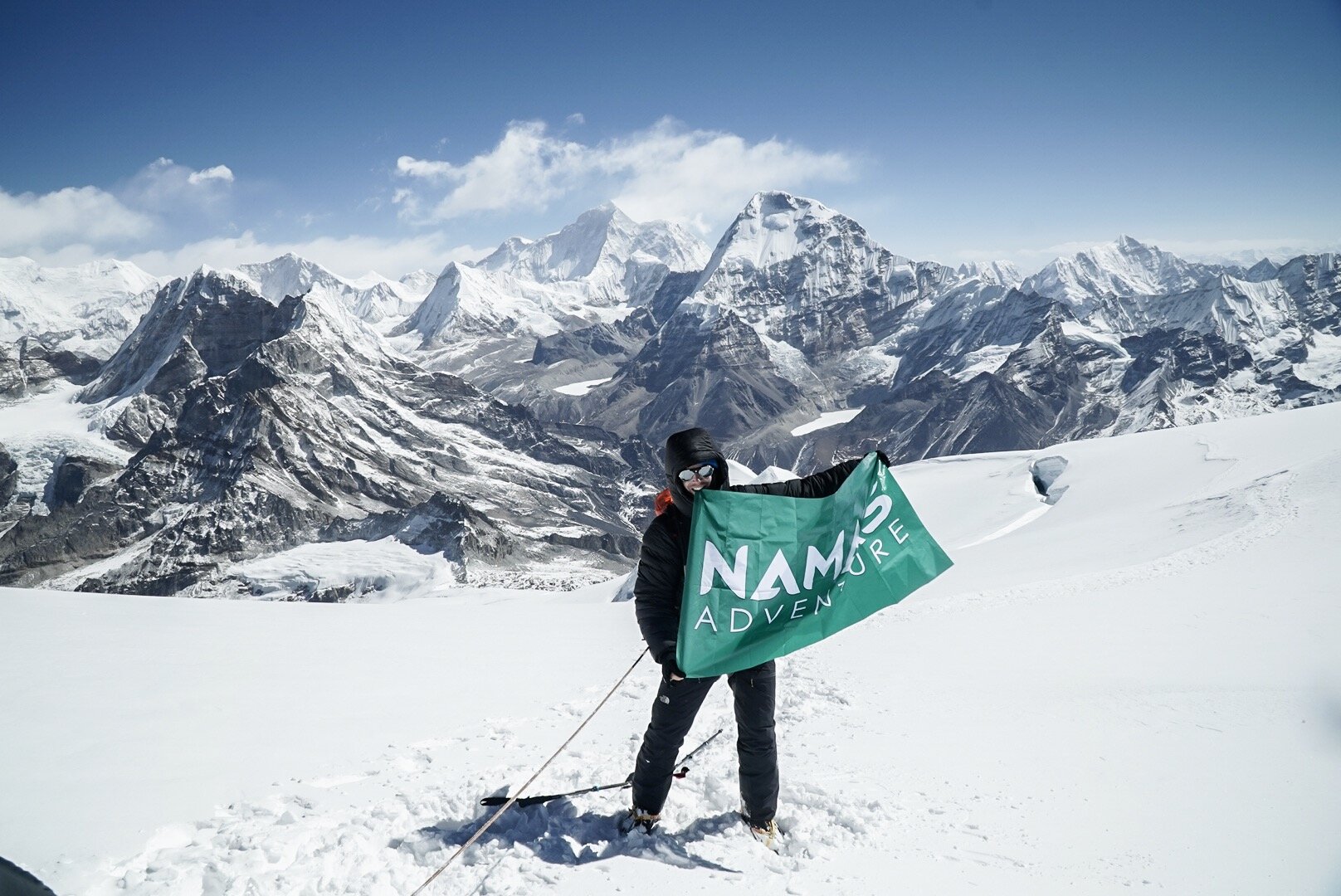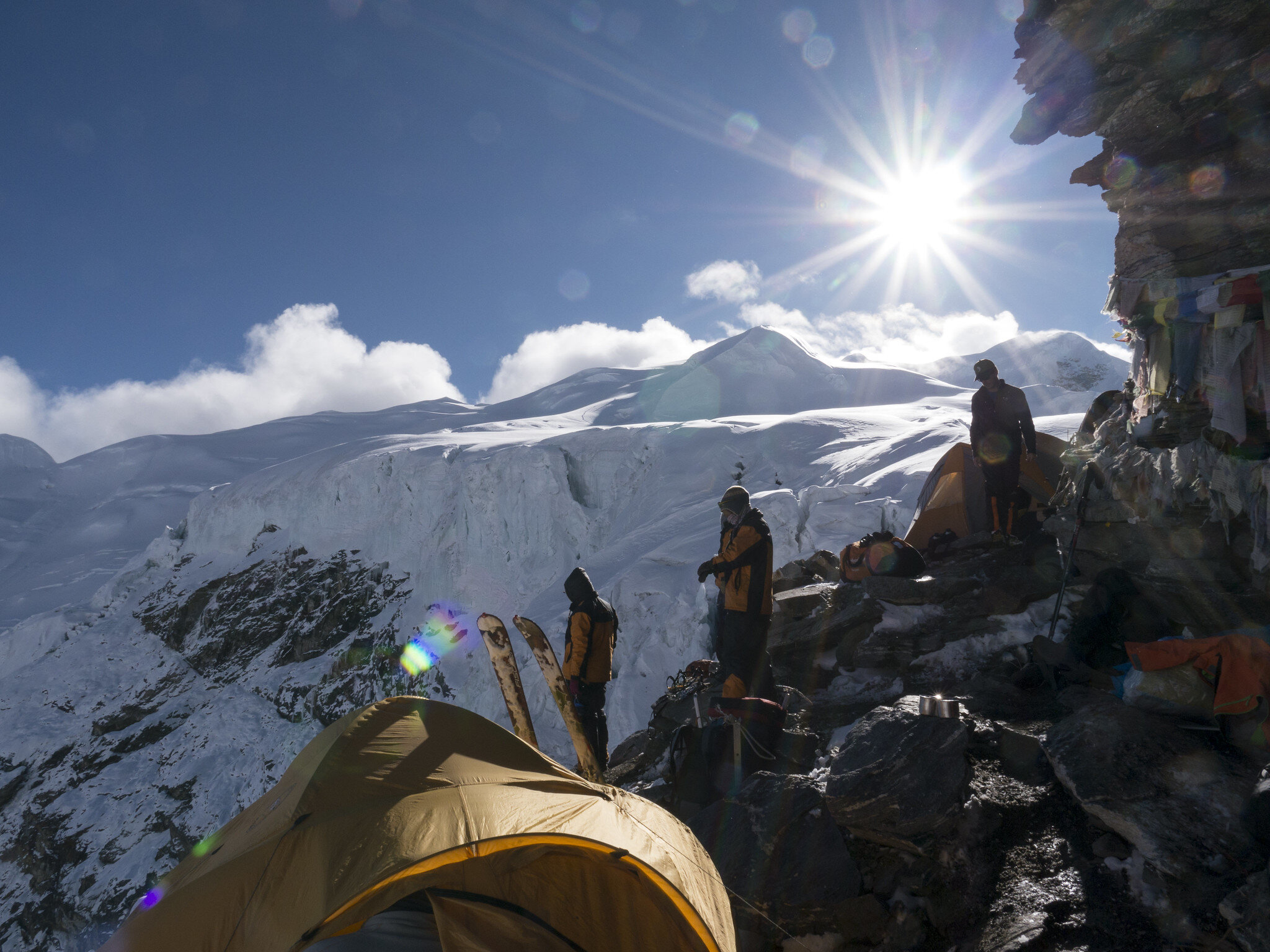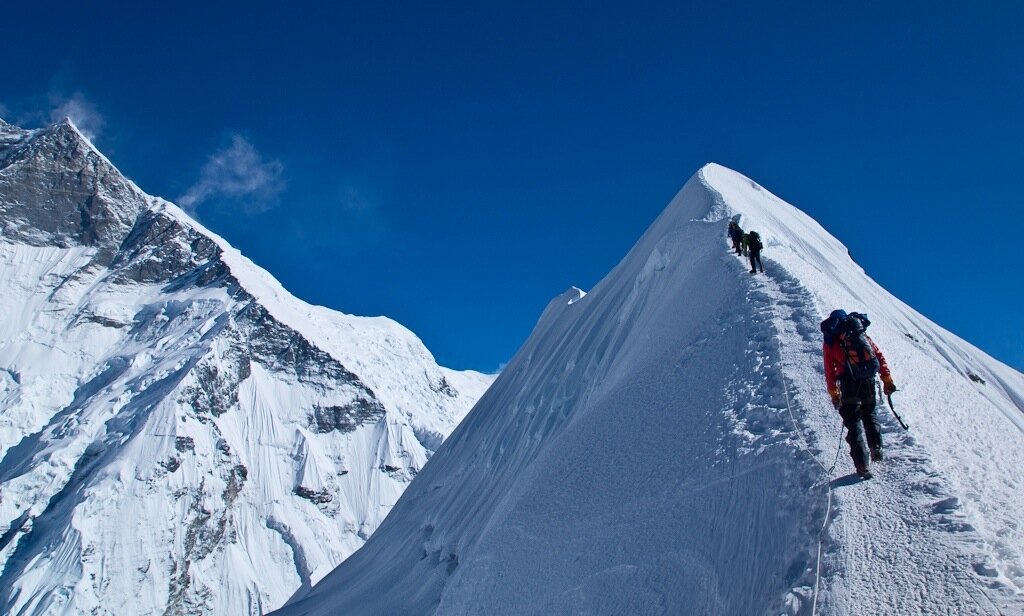Everything you need to know about Mera Peak 6476M climb - Namas Adventure
Summit of MeraCancel Peak 6476M
Everything you need to know about Mera Peak 6476M climb
Mera Peak is one of the best climbing peaks suitable for all beginner/novice climbers. Even if you are an experienced climber who wants to enjoy a decent climbing holiday, then Mera peak still is a good choice. Located in Makalu Barun Valley, this peak offers one of the most perfect remote adventure holiday experiences. Trekking through the remote villages, rugged trail paths up and down the hills, through forest trails and of course beautiful mountains all around.
But before you embark on one of the most amazing adventures, we have listed 11 useful informations that will help you prepare for your Mera peak climbing expedition.
1. When is the best time to climb Mera Peak?
Mera Peak is best suited to climb during two climbing seasons. Spring (March-May) and Autumn (September - November). During both the season there aren’t as many climbers as other peaks such as Island Peak. So climbers can expect a low-medium number of climbers.
For experienced climbers, winter climb is still possible but this comes with a lot of uncertainties. i.e unstable conditions, tea houses may not be operational or even the ones operating won’t be well-stocked. Pre-arrangements will have to be made but that will also depend on the number of climbers.
2. Is it possible to shorten Mera Peak climb?
Mera peak climbing can definitely be shortened but this comes at an additional cost. At Namas adventure, we do provide these services for private client groups ( 2+ members). The shortest Itinerary we can make it up to is 10 days Itinerary. Extra charges apply of an additional $4000 - $4500 applies since we will have to charter helicopter services. Please contact our team for other flexible options.
3. How much does it cost to climb Mera Peak? What does the cost include?
With Namas Adventure, Mera Peak costs $3650/£2850/€3300 per person. We provide premium high-quality all-inclusive peak climbing services. Climbers do not have to worry about anything with our team and totally focus on their climbing holiday and fun times ahead.
List of what’s included in your booking.
NMA Certified Sherpa Mountain guide
$300 Individual tip pool. Tip pool will be fairly distributed among all Namas staff members. (Guides, porters, drivers, hotel security, and staff). Guest may personally hand in extra tips to our guides and porters.
Namas Branded merchandise (Down Jacket, Cap, Buff)
1:2 Sherpa Guide: Client ratio
Cook and helping team at Base Camp and High Camp
35Kgs per person
Arrival hotel in Kathmandu
All trekking and climbing permits (Khumbu Region Permit and TIMS)
All internal-local transportation to and from the trekking trailhead
Breakfast, Lunch, and Dinner on trek and expedition days.
1 Pot of hot water every night
Hydration tablet, frozen foods at BC and high camps
Lodge accommodation during the trek
Porters
Arrival pick up and departure
Internal flights
Basic First aid kit
Welcome/Farewell leave Dinner
4. Are guides necessary for Mera Peak?
To issue a permit for Mera Peak climb, you will have to go through a registered local company, for this purpose guides are hired. For beginner to intermediate climbers, we highly suggest climbing the peak with guides. The usual climbing route does have a crevasse and new hazards may appear every climbing season. Experienced climbers/guides who want to venture into new routes will still have to be assigned a local guide even if they don’t prefer them climbing with them. So, yes legally speaking guide assistance is required.
5. What is the best acclimatisation itinerary for Mera Peak climb?
On high altitude climbing trips like Mera Peak climbing expedition, it’s imperative that climbers acclimatize properly so that the body is well-rested, adapted, and stronger to climb even higher. With years of climbing -guiding experiences and well-known scientific literature, we know that our bodies need an adequate acclimatization period to adapt to the environment after gaining a certain elevation. With that knowledge and experience, our team has built up the following Mera Peak Itinerary.
On Mera Peak climbing trip, we make sure your itinerary has both Mera Peak base camp and high camp. Your body needs these adaptation periods when you are above 5000M+. This way you can experience alpine camping, enjoy the Himalayas all around you, and had gain enough strength to make your summit climb.
6. What training required to climb Mera Peak? Can you suggest me a training plan?
Mera Peak is by no means an easy climb even though we grade it as a beginner’s climb. Mountains are graded based on their technical and physical difficulties. For your training, we highly recommend climbers to focus on endurance and strength training. Any type of aerobic exercise, like long-distance running (10-15km) 3 to 4 times a week, cycling (1 hour - 2 hours), hiking gaining elevation with 10-15kgs weights on are some of the suggested training. More on our training mountain expedition blog.
Courses like beginner mountaineering classes are also a helpful tool. You will learn technical skills like climbing with a rope on 5/6 anchor points using ascenders, how to walk with crampons on ice, snow, and rock, and to be efficient with abseiling and overall gear safety checks awareness.
7. How hard is Mera Peak climb?
Mera peak is graded at 1B. (Alpine grading link).
If you are physically fit, then the final 2 days of your climb are the most difficult sections. Breathing is always a challenge at high altitudes but with proper acclimatization done ahead of time, staying well hydrated, eating properly, your body should recover and adapt to the altitude. Once you depart from Mera Base camp the real alpine challenge begins, mostly climbing on steep ice and snow surfaces. You will be walking for 4-6 hours to reach high camp. Summit day climb starts early (3 or 4 am) with the goal to reach the summit or near to the summit by sunrise. This will be the most challenging and rewarding part of the climb. You can expect to hike around 10+ hours on this day as you will have to summit and then descend back to Khare village. All your previous physical training, your will, mental strength, and your grit for real adventure will take you through this final day and to the Summit.
8. What are the clothing and gears - boots required for Mera Peak climb (trekking and mountaineering)? Can I rent gears for Mera Peak climb?
Choosing the right gear is very important. We advise climbers not to make compromises on the quality of gears and clothing, and to pay attention to layer up comfortably as well. You will highly depend on your clothes to keep you warm, especially during nighttime when temperatures can go down to -10/-15. Please check our equipment blog for recommended clothing and gears.
Renting your gears in Nepal? We provide gear rentals exclusively for Namas Adventure clients during our climbs. All the gears are in the best condition, clean, and highest quality. Kailas equipment provides all-out mountaineering gears. (Namas Equipment hire link)
If you want to hire it from other local sources in Nepal, our simple answer is NO. This is one of the most frequently asked questions mainly by beginner climbers. We have tested and tried several gears in Nepal and frankly, we do not recommend hiring here. We know it might seem like a huge amount of expenses to buy all the gears, but they are well worth it.
Boots (trekking and mountaineering) for Mera Peak
With better technologies, climbing shoes have improved every year. We highly recommend double-layered boots like La Sport G2Sm or Scarpa phantom. It is wise to spend on good mountaineering boots, as so with all the gears that we have mentioned in this post above.
9. What types of foods are available during Mera Peak climb? Is clean water available and how much water intake is recommended?
We suggest all our clients drink 4-6 l of water every day. Staying hydrated will also help you with acclimatizing properly. It’s best to take hydration tablets or filtration bottles with you.
Most of the foods are prepared in the tea houses and during your climbing days, kitchen tents are set up by our Sherpa teams. You do not need to worry about food but remember to eat enough. In the high altitudes, your body will naturally want to reject food or avoid using energy on anything, which includes eating too. You might have to force yourself with the first few couple of bites and then eventually your body will start accepting the food. We also provide packed dried meals, so that clients have other options should they not want to eat what’s being cooked in the tents.
Remember to avoid smoking and any alcohol intake. You might see our guiding leaders smoking or drinking but remember they are professionals and they have adapted very well to these environments compared to the climbers who go there just for adventure holidays.
10. What trip insurance will I need for Mera Peak climb? Do I need helicopter evacuation to be included in my insurance cover?
No matter how prepared you are, you never know when or how things might go wrong. You might be sick suddenly or not that we wish but there might be some incident, you might suffer from altitude sickness or anything we can’t imagine yet. So, for these reasons, it is always good to have insurance cover. Our recommended Insurance companies (link)
Helicopter evacuation is our final emergency option and we do recommend you have one in your insurance, as it is the only means of transport in the Everest region. Our guides will assess your condition and examine if it is a major issue. If not, they will use their experience to motivate and push you through your trip. However, in case of emergency, helicopter evacuation will be called upon.
There is a procedure to follow when calling for emergency evacuation. We will call the insurance company hotline, get approval with your insurance and only then helicopters are sent to the distress call location. You will have to pay for the evacuation in Nepal from your own pocket but once you are back home you can claim your money back. Make sure you collect helicopter evacuation receipts, certified doctor’s approval letter. The insurance company will ask for this evidence to back up your claim. There was a huge helicopter scam in Nepal during 2018, so insurance companies are taking extra measures to stop this from happening. Our guides and staff members in Kathmandu will also remind you of this process during briefings.
11. Which other high-altitude peak climbing can I aim for after Mera Peak climb? Can I combine other 6000M+ peaks with Mera Peak climb?
If you want to extend your trip and combine other 6000M peaks along with Mera peak, then we would like to recommend the following two other itineraries.
Mera Peak and Island Peak climbing
Island Peak is another 6100+ M peak that includes some technical climbing sections compared to Mera peak. To reach Island peak after Mera Peak climbers will have to climb via Amphu Laptsa Pass 5845M and then descend to Imja valley. Island peak is also known as Imja Tse peak (Local name).
Island Peak 6189M
This expedition program is the holy grail and the best possible introduction to Himalayan climbing - we ascend three beautiful 20,000 foot (6000+ meter) peaks which is one of the most spectacular settings in the world. Join this trip for great trekking, a rewarding cultural experience with the Sherpa people, and a challenging feat on climbing on Mera Peak (6,476M), Island Peak (6189M), Lobuche East (6119M).
Once you have completed your Mera Peak climb and when you feel like you want to take on higher peaks we can suggest other 7000M+ - 8000M+ peaks that you can aim for. Baruntse Peak Expedition 7129M, Himlung Himal Expedition 7126M or Manaslu Expedition 8163M.
Baruntse Base Camp 5300M
Mera Peak is one of the most exhilarating adventure of a lifetime. Like every other mountain climbing trip this is a worthwhile adventure. We hope the information we have provided above will help you decide/prepare in the best way before you embark on your Mera Peak climbing expedition. If you are looking for a great climbing trip and have an amazing time in Nepal then we would love to have you onboard for our Mera Peak climbing trip. You can be assured that you are provided quality services with our fun-loving yet professional guides who have 5 - 10+ years of taking clients on such peak climbing trips. After all we do aim to be the best adventure specialist in the world and you having a great time, being safe and summiting will always be our priority.
If you do have any more questions, please ask us below in the comment section or you can email us at bookings@namasadventure.com and our team will get back to you as soon as they can. Stay well. Challenge yourself. Dare great things and live your story.










